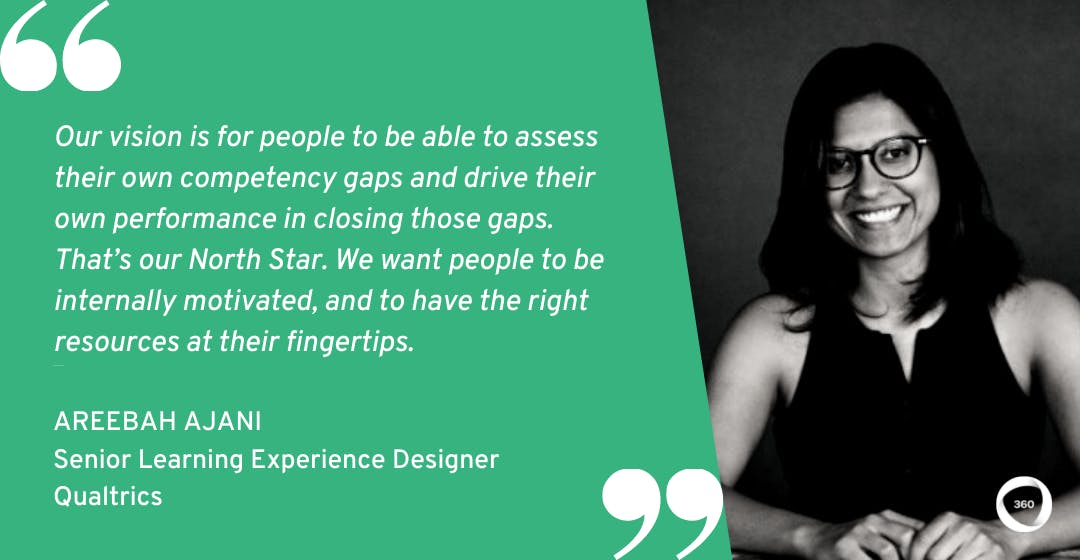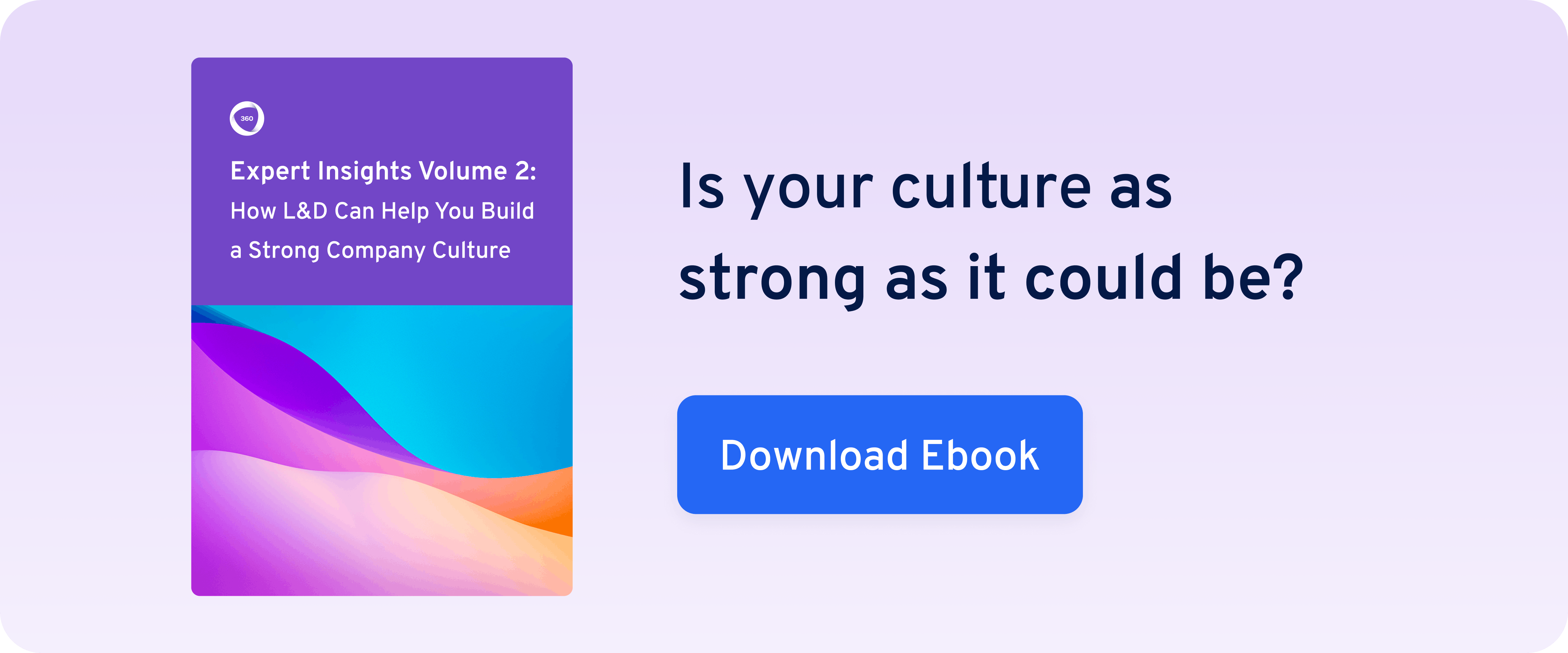
How Qualtrics Built a Competency Diagnostic Tool to Focus on the Right Development Priorities
Making sure your organization is focusing on the right employee development priorities is one of the hardest jobs in L&D. It can be challenging enough to define these priorities just for one person–defining them for a whole business can seem impossible.
This question might be difficult, but it’s crucial to company growth. Your organization is like an aircraft carrier: with tiny and impactful adjustments, you can make sure you’re heading in the right direction.
At Qualtrics, Senior Learning Experience Designer Areebah Ajani has been doing just that. And recently, I sat down with her to learn more about how she built a competency diagnostic tool to focus on the right employee development priorities and shift the needle on growth.
Read on to find out how using a competency diagnostic tool can make a big impact for your whole organization.
Seeing employee development with a customer experience lens
Experience management company Qualtrics is all about helping businesses everywhere offer the best possible experiences for clients and users.
“Qualtrics is an experience management company," says Areebah. "Our platform and services are helping teams in customer experience, employee experience, product design, and brands more generally to track and improve their constituents’ experiences. It’s about going through the whole life cycle of a buyer or an employee.”
For Areebah, this focus on customer experience isn’t just a priority for Qualtrics’s clients–it’s also a big focus for Qualtrics. “As our clients are focusing on better experiences for their employees and buyers, we’re also drinking our own champagne by testing the life cycle for our customers, too.”
“I work within the Global Enablement team, and within that, I sit within a Solutions team comprised of learning designers and project managers. We’re engaged in different projects across the organization to help drive better employee experience, better learning and development, and to meet our overall sales and customer support goals.”
One of these projects? Setting the right development priorities while scaling.
As our clients are focusing on better experiences for their employees and buyers, we’re also drinking our own champagne by testing the life cycle for our customers, too.
You can never have enough expert insights! Check out our ebook to find out How L&D Can Help You Build a Strong Company Culture
The challenge of setting development priorities while scaling
Right now, Qualtrics is growing like crazy. As Areebah explains, this growth needs to be supported with the right priorities for employee development.
“Because Qualtrics is growing so much, we’re hiring a lot of managers and reps. We often say, ‘what got us here is not going to get us to the next level’. We’re getting a lot of new talent, and people don’t have the same tribal knowledge of the people who have been with us since the beginning of the company. Our challenge has been to create a more predictable and scalable experience of growing skills and learning to excel in your role once you arrive at Qualtrics.”
“The project we needed to tackle first was to assess and refine our baseline competency model. Having a simplified model that communicates what it takes to do a good job at Qualtrics can help us organize our learning ecosystem and communicate with both newcomers and our existing teams what it takes to improve and do better at your job.”
At 360Learning, we’re also scaling right now. That’s why I wanted to hear more about how refining this competency model could help Qualtrics define top performance and keep up with the pace of change. Fortunately, Areebah was happy to explain.
We’re getting a lot of new talent, and people don’t have the same tribal knowledge of the people who have been with us since the beginning of the company.
How a competency diagnostic tool enables better decisions at 3 levels
For Areebah and her team, building a new competency diagnostic tool has been a great way to empower learners to take charge of their own goals.
“Our vision is for people to be able to assess their own competency gaps and drive their own performance in closing those gaps. That’s our North Star. We want people to be internally motivated, and to have the right resources at their fingertips, whether we’re talking about online events, live events, coaching, or any other part of the learning experience.”

So, how is this going for Qualtrics so far? “We’re making progress,” says Areebah. “We started off with workshops on our sales rep competencies based on what our high-performers do, and we developed a simplified model of these competencies to get to the essential skills. That model for reps then powers a competency diagnostic that goes out twice a year.”
“With this diagnostic, reps assess their own skills, as well as having managers and other go-to-market peers assess their skills too. That gives people the data to identify gaps at an organizational level, at a team level, and then to shape recommendations for individual improvements.”
As Areebah says, this diagnostic tool helps Qualtrics to make better performance development decisions at three different levels.
#1: Defining organizational development priorities
“With the data from our diagnostic, you can make decisions on how to alter your action plan at an organizational level. It’s really great, because we don’t have to apply a one-size-fits-all competency model, though we can still identify global trends and larger priorities, such as a gap in resources to support certain competencies.”
#2: Defining team development priorities
“At the team level, managers can see from the open-text responses and the results of the competency diagnostic that they may need to focus their coaching on identifying buyers, for example, or on navigating the internal ecosystem. It helps them know what to focus on.”
#3: Sorting existing learning content to match new competencies
“A third use of this model is, we can tag all of our learning content and sort it according to the new competencies. That will help get us to the point where we can predict or prescribe the learning paths based on how individuals are doing. It’s an ongoing project.”
This competency diagnostic tool is a great example of Collaborative Learning and the shifting role of L&D teams. Instead of simply setting development priorities from the top down, L&D teams are providing the right tools for people to measure their capabilities and take learning into their own hands.
Related: How Gong Built a Performance Management Approach to Attract, Motivate, and Reward Ambitious People
The impact of Qualtrics’s new competency diagnostic tool
For Areebah, there are a few different ways to measure the impact of Qualtrics’s new competency diagnostic tool. “Initially, we were wondering at which level we were going to measure the impact of this shift. We could use learner satisfaction scores with online learning, because we have targets and benchmarks we use to measure our performance here.”
“Then, there are the big bets that come down through the company. These are things we all need to achieve, such as our sales quota or other targets. We decided to focus on action plan efficacy: how well did our learning interventions move the needle on priority competencies? This can tell us if the interventions are working, and that we’re moving in the right direction.”
As Areebah explains, it’s helpful to stay realistic. “This is not to say that we need to get to a full spider graph where everyone has every competency all of the time. That’s not where we’re headed, and it’s not the goal. What we’re trying to decide is, are we adaptive? Are we able to meet the needs of a certain competency gap each time we run this assessment?”
For Qualtrics, this new approach also helps to target learning strategies. “The competency diagnostic is a biannual assessment, and it’s the second time we’ve run it. Now, we’re seeing that where we prioritized efforts, we are seeing slight regional upticks in how people responded. For example, our sales methodology was important in one region and negotiation skills were important in another. In both regions those skills did a little better this time around.”
“Overall, when there’s a noticeable global trend, that takes a little longer to come through. It doesn’t happen in one quarter. We can show that we’re still trending okay, but in order to see measurable change, we need to continue reinforcing the assessment and making bigger investments in priority areas. It’s a long-term goal for us.”
Related: 3 Data-Based Ways to Prove Training ROI (+ Free Training ROI Calculator)
This is not to say that we need to get to a full spider graph where everyone has every competency all of the time. That’s not where we’re headed, and it’s not the goal.
Thanks again to Areebah for taking the time to chat!
And if you’re looking for more expert insights about performance measurement, check out my interviews with Ryan Giordano of Gong about how to motivate ambitious people, and with Joshua Clark of Cisco about empowering employees to navigate career opportunities.
Want more peer insights on transforming workplace learning? Check out #CLOConnect, our interview series with top L&D leaders on driving growth and scaling culture through Collaborative Learning. Or you can subscribe (below 👇) to our weekly newsletter to receive our latest posts directly in your inbox.


